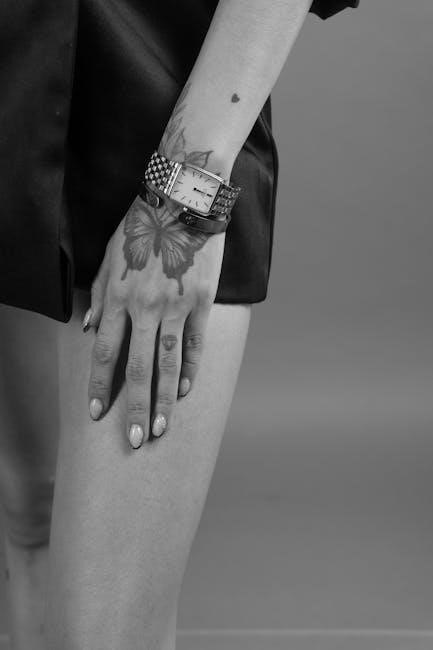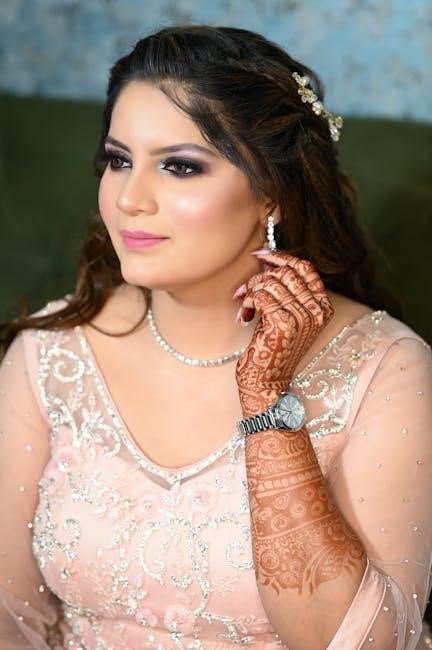
Welcome to our watch size guide for women. Discover how to choose the perfect timepiece based on your wrist size, from petite to bold styles. Ensure a comfortable, stylish fit.

How to Measure Wrist Size
To measure your wrist size, wrap a flexible tape measure snugly around the narrowest part of your wrist. Note the circumference in centimeters or inches for an accurate fit. This ensures the perfect watch size.
Step-by-Step Guide to Measuring Your Wrist
To measure your wrist accurately for a watch, follow these steps:
Use a flexible tape measure or a string.
Wrap it snugly around the narrowest part of your wrist, just above the wrist bone.
Ensure the tape measure is level and not too tight or loose.
Read the circumference in centimeters or inches.
Note the measurement to determine your watch size.
This method ensures a precise fit, balancing style and comfort. For women, wrist sizes typically range from 14 cm to 18 cm, with 16 cm being average. Use this guide to find watches that complement your wrist size perfectly. Always measure mid-day for accuracy, as wrists can swell slightly during the day. If unsure, consider the watch style, as larger watches may require adding a few millimeters to your measurement. Accurate sizing ensures your watch looks proportional and feels comfortable.
Factors Affecting Wrist Size and Watch Fit
Several factors influence wrist size and how a watch fits. Women’s wrist sizes typically range from 14 cm to 18 cm, with 16 cm being the average. Body proportions, bone structure, and muscle mass play a significant role in determining wrist size. For example, women with smaller frames or slimmer wrists may prefer watches with case diameters under 36mm, while those with broader wrists can opt for larger styles. Personal style also impacts fit preferences, as some women prefer snug, delicate watches, while others favor bold, statement pieces. Additionally, factors like the time of day (wrist size can slightly increase due to swelling) and the type of strap or band can affect comfort and appearance. Understanding these elements ensures a watch complements both wrist size and personal aesthetic, creating a balanced and stylish look.
Common Mistakes When Measuring Wrist Size
When measuring wrist size for a watch, several common mistakes can lead to an inaccurate fit. One of the most frequent errors is not using a flexible tape measure, which is essential for obtaining an precise circumference. Many people measure too tightly or too loosely, which can result in a watch that is either too snug or too loose. Another mistake is measuring at the wrong position; the tape should be placed mid-way between the wrist bones for an accurate reading. Additionally, some individuals forget to consider the time of day, as wrists can swell slightly due to activity or temperature. Relying solely on average sizes without personal measurement is also a common oversight. To ensure the best fit, measure carefully, maintaining a relaxed wrist position, and avoid guessing based on general guidelines. Accurate measurement is key to selecting a watch that feels and looks right.
Watch Case Diameter
Watch case diameter is crucial for style and comfort, varying based on wrist size and personal preference. Smaller diameters suit petite wrists, while larger sizes make a bold statement, aligning with current trends.
Case Diameter for Small Wrists (Under 14 cm)
For women with wrists measuring under 14 cm, watches with smaller case diameters are ideal for a proportional and elegant look. A case diameter of 26mm to 30mm is typically recommended, as it complements the slimmer wrist without appearing oversized. This size range ensures the watch sits comfortably and maintains a balanced aesthetic. Smaller case diameters, such as 28mm or 32mm, are particularly flattering, offering a delicate and sophisticated appearance. Watches in this range are perfect for everyday wear, pairing seamlessly with both casual and formal outfits. For wrists closer to 14 cm, a slightly larger case, such as 34mm, can also work well, depending on personal style. However, avoid larger diameters, as they may overwhelm the wrist. Opting for a smaller case ensures a refined and harmonious fit, making it ideal for petite wrists.
- 26mm-30mm: Ideal for wrists under 14 cm.
- 28mm-32mm: Perfect for a delicate, elegant look.
- 34mm: Suitable for wrists closer to 14 cm.
Choosing the right case diameter ensures comfort and style for smaller wrists.
Case Diameter for Medium Wrists (14-16 cm)
For women with medium wrist sizes (14-16 cm), a watch case diameter of 30mm to 36mm is typically recommended. This range offers a balanced and proportional fit, ensuring the watch neither appears too small nor overwhelms the wrist. A 32mm or 34mm case diameter is particularly flattering, as it complements the natural curves of a medium wrist while maintaining a sleek, sophisticated appearance. Watches in this size range are versatile, suitable for both casual and formal settings. They also pair well with various strap styles, from delicate leather to sturdy metal bands. For those who prefer a slightly larger or smaller timepiece, 30mm and 36mm cases are excellent alternatives. Ultimately, this size range strikes the perfect harmony between style and comfort, making it ideal for everyday wear.
- 30mm-36mm: Ideal for wrists between 14-16 cm.
- 32mm-34mm: Perfect for a balanced, elegant look.
- 30mm and 36mm: Great alternatives for personal preference.
This range ensures a timeless and adaptable fit for medium wrists.
Case Diameter for Large Wrists (Over 16 cm)
For women with larger wrists (over 16 cm), a watch case diameter of 38mm to 42mm is highly recommended. This size range provides a bold yet elegant fit, ensuring the watch complements the wrist without appearing oversized. A 40mm case diameter is particularly popular, as it strikes a balance between style and comfort. Larger wrists can also accommodate watches with case diameters of 44mm or more, especially for those who prefer a statement piece. These sizes are often associated with unisex or men’s watches but can still look feminine with the right design and strap. The key is to ensure the watch proportions align with personal style and comfort preferences.
- 38mm-42mm: Ideal for wrists over 16 cm.
- 40mm: A versatile and popular choice.
- 44mm+: Suitable for bold, statement-making timepieces.
Larger case diameters offer a sleek, modern aesthetic for women with bigger wrists.
Unisex Watch Options for Women
Unisex watches offer a versatile option for women, blending classic designs with a modern, gender-neutral aesthetic. Typically, unisex watches feature case diameters between 38mm and 42mm, making them suitable for a wide range of wrist sizes. These watches are ideal for women who prefer a sleek, understated look or those who enjoy a bold, statement-making timepiece. Many unisex styles are designed with clean dials and interchangeable straps, allowing for customization to suit personal preferences. They are also versatile enough to complement both casual and formal outfits. For women with medium to large wrists, unisex watches provide a perfect balance between style and comfort. The trend toward larger case diameters has made unisex options increasingly popular, as they offer a timeless appeal that transcends traditional gender norms in watch design.
- Case diameters: 38mm-42mm.
- Versatile designs for any occasion.
- Interchangeable straps for customization.
Unisex watches are a chic and practical choice for women seeking a sophisticated timepiece.
Trend Towards Larger Case Diameters
In recent years, there has been a noticeable shift toward larger case diameters in women’s watches, with many opting for bold, statement-making timepieces. While traditional women’s watches often featured smaller cases (26-36mm), modern designs now embrace larger diameters, ranging from 38mm to 42mm and beyond. This trend reflects a desire for versatility and a more contemporary aesthetic. Larger watches are not only fashionable but also practical, as they are easier to read and can complement both casual and formal outfits. For women with larger wrists, cases above 42mm can be particularly flattering, while smaller wrists can still pull off slightly oversized styles. The trend emphasizes proportionality, ensuring the watch complements the wearer’s wrist size without appearing overwhelming. This shift has expanded the options for women, allowing them to choose timepieces that align with their personal style and preferences.
- Larger case diameters (38mm-42mm) are increasingly popular.
- Bold designs offer a modern, versatile aesthetic.
- Proportionality ensures a balanced, stylish fit.
The trend toward larger cases has redefined traditional watch sizing for women, offering a fresh, contemporary approach to timepiece design.
Strap Length and Width
Strap length and width are crucial for comfort and style. The ideal width complements the case size, while the length ensures a secure fit. Proper proportions enhance both aesthetics and functionality.
How to Choose the Right Strap Length
Choosing the right strap length ensures a comfortable and secure fit. Measure your wrist circumference to determine the ideal strap size. For wrists under 14 cm, opt for a shorter strap (160-170mm). Medium wrists (14-16 cm) suit standard lengths (170-180mm), while larger wrists (over 16 cm) require longer straps (180-190mm). Consider the watch case size, as larger cases often pair better with longer straps for balance. Personal preference also plays a role, so try before buying if possible. Adjustable straps are a practical option for versatility. Ensure the strap is snug but not tight, allowing space for one finger between the strap and wrist. Proper fit enhances both comfort and aesthetics, making your watch a perfect accessory for any occasion.
Ideal Strap Width for Different Case Sizes
The ideal strap width complements the watch case size, ensuring a balanced look. For smaller cases (26-36mm), narrower straps (16-18mm) are recommended, as they proportionally match the watch’s delicate design. Medium-sized cases (38-42mm) pair well with straps measuring 19-20mm, providing a harmonious balance. Larger cases (44mm and above) are best paired with wider straps (21-22mm) to maintain visual equilibrium. Strap width should also align with your wrist size; narrower straps suit slimmer wrists, while wider straps can accommodate larger wrists. Current trends lean toward slightly wider straps for a modern aesthetic, but personal preference plays a significant role. Ensuring the strap width aligns with the case size enhances both comfort and style, creating a cohesive and polished appearance for any occasion. Always consider these guidelines when selecting a strap to achieve the perfect fit and look for your watch.

Style Considerations
Ensure a proportional fit by balancing watch size with wrist circumference and personal style. Consider face shape and band type to enhance aesthetics, creating a harmonious blend of comfort and elegance.
Ensuring a Proportional Fit
A proportional fit is key to styling a watch for female wrists. The watch case should complement wrist size, with smaller wrists (under 14 cm) suiting 26-30mm cases, while medium wrists (14-16 cm) look best with 30-36mm cases. Larger wrists (over 16 cm) can carry 38mm and above. Strap width should also align with case size, ensuring harmony. For instance, narrower straps (16-18mm) pair well with smaller cases, while wider straps (19-22mm) balance larger ones. Face shape influences proportions too—oval faces suit round or oval watches, while square faces benefit from softer shapes. Balancing style and comfort ensures the watch enhances your look without feeling overpowering. Measure your wrist and consider these guidelines to find a timepiece that flatters your frame and personal taste, creating a seamless, polished appearance.
How Face Shape Influences Watch Choice
Your face shape plays a significant role in selecting a watch that flatters your overall look. For women with oval faces, round or oval watches complement their symmetry, while square or rectangular faces benefit from softer, curved designs to balance angular features. Heart-shaped faces look stunning with wider straps and smaller cases, drawing attention downward. Pear-shaped faces can opt for bold, statement pieces to create balance. Consider the proportions of your face and how the watch will sit on your wrist. The right style enhances your natural beauty, ensuring a harmonious and polished appearance. Pairing your face shape with the appropriate watch design creates a cohesive look, making your timepiece a perfect accessory for any occasion. This consideration, alongside wrist size, ensures your watch is both stylish and flattering, tailored to your unique features and personal style.
Metal vs. Leather Bands: Which Suits You Best
Choosing between metal and leather bands depends on your personal style, lifestyle, and wrist size. Metal bands offer a sleek, timeless look and are highly durable, making them ideal for both casual and formal occasions. They are also adjustable, ensuring a precise fit for various wrist sizes. Leather bands, on the other hand, provide a softer, more elegant appearance and are lightweight, making them comfortable for everyday wear. Leather bands are versatile and can complement both petite and larger wrists, depending on the design. Consider your daily activities and preferences: metal bands are low-maintenance and perfect for active lifestyles, while leather bands add a touch of sophistication. Ultimately, the choice depends on whether you prioritize durability and versatility or comfort and style. Both options can enhance your watch’s aesthetic and ensure a flattering fit for your wrist. Balancing practicality and personal taste will help you make the best decision.

How to Choose the Right Watch
Selecting the perfect watch involves measuring your wrist, considering your style, and ensuring comfort. Choose between elegant, sporty, or minimalist designs, and prioritize durability. Personal preference for metal or leather bands also matters.
Balancing Style and Comfort

Balancing style and comfort is key to finding the perfect watch. A timepiece that complements your wrist size ensures both aesthetics and wearability. Smaller wrists look best with slimmer designs, while larger wrists can handle bold styles. Consider the case diameter relative to your wrist circumference for a proportional fit. Strap material, such as leather or metal, impacts comfort and durability. Opt for adjustable straps to ensure a secure fit. Trends lean toward larger watches, but personal preference and wrist size should guide your choice. Ensure the watch isn’t too heavy or restrictive. Pairing the right band width with the case size enhances comfort and style. Ultimately, the ideal watch blends seamlessly with your lifestyle and personal taste, offering both functionality and flair.
Popular Watch Brands for Women
Several watch brands are renowned for their stylish and well-fitting timepieces for women. Rolex, Cartier, and Omega are favorites for their elegant designs and precise craftsmanship. Swatch and Fossil offer trendy, affordable options, while Michael Kors and Kate Spade provide fashion-forward styles. Audemars Piguet and Patek Philippe cater to luxury seekers with intricate details. For petite wrists, brands like Longines and Rado offer slim, sophisticated models. Meanwhile, larger wrists can embrace bold designs from Hublot or IWC. Many brands now create unisex watches, giving women more versatility. Personal style and wrist size play a big role in choosing the right brand. Whether you prefer classic simplicity or modern flair, there’s a brand to suit your taste. These brands ensure a perfect blend of style, comfort, and functionality, making them top choices for women seeking the ideal timepiece.
Budget Considerations
When selecting a watch, budget plays a crucial role. Watches vary widely in price, from affordable options under $100 to luxury timepieces costing thousands. For women, fashion watches from brands like Fossil or Michael Kors often range between $100-$500, offering style without a hefty price tag. Mid-range options from brands like Tissot or Citizen provide excellent value, typically priced between $300-$800. Luxury brands like Rolex or Omega are investment pieces, starting around $5,000 and upwards. Consider materials and features; leather straps and quartz movements are generally more budget-friendly than metal bracelets or automatic mechanisms. Setting a budget helps narrow choices and ensures a purchase aligns with financial comfort. Additionally, exploring sales or pre-owned options can offer significant savings. Balancing budget with desired features and style ensures finding a watch that meets both financial and aesthetic needs.
Selecting the right watch for your wrist size and style is a balance of comfort, aesthetics, and personal preference. By understanding your wrist measurements and matching them to appropriate case diameters and strap lengths, you can ensure a proportional and flattering fit. While trends like larger watches are popular, smaller, delicate designs remain timeless for petite wrists. Ultimately, the best watch is one that complements your lifestyle and budget. Whether you prefer minimalist designs or statement pieces, there’s a timepiece tailored to your unique taste and needs. Remember, proper fit enhances both comfort and style, making your watch a trusted companion for years to come.
Leave a Reply
You must be logged in to post a comment.